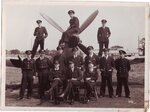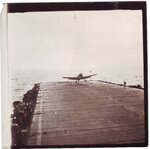My grandfather W.G.Batham (Guy) was a FAA pilot in 1943-45. He was in 885 Squadron where he was a spotter flying Seafire III's on D-Day before he went to the Pacific on HMS Ruler and joined 1844 Squadron on HMS Indomitable flying Gumman Hellcats. Incredibly he never felt it necessary to tell any of his family this until very recently. He's about to celebrate his 96th birthday in November and I've been in touch with the MoD who tell me he is entitled to be awarded Chevalier De La Legion D'Honneur for his service on D-Day. They've just sent what I've found so far over to the French Embassy for consideration but I'd like to continue my research and make sure I have all the evidence needed if they ask any questions.
We would probably never have learned about grandads role in the war if it hadn't been for a comment he made about his car number plate reading 886 which he said was annoyingly one away from 885, the number of his former squadron! We asked him to explain a little more and he went on to tell us about him once being a pilot. We knew his parents and siblings were decorated officers and had been mentioned in dispatches but grandad never really said anything about his role. I've found him in the UK Navy lists so his recollection of the squadron number is accurate.
Grandad had all his service medals stolen in 1987 and we have no documents from that era as he likely chose not to keep them. However, I have found quite a lot about him online already. 885 were part of 34 recon wing and his job was to fly over the D-Day beaches and radio the ships in the channel the location of the enemy guns. He says he was involved in a dog fight but when asked about it says someone else got credit. One of his fellow 885 FAA pilots died that day. I've found a book by George Boyd called Boyds War, George served alongside my grandfather in 885 so I hope to get a copy of his book soon.
Grandad is mentioned on this website in 1844 Squadron: 1839 Naval Air Squadron where it says he shot down a Japanese Zeke on his first mission. He was also onboard HMS Indomitable during a Kamikaze attack. He also mentioned he did a flypast over Sydney harbour on VJ Day in his Hellcat. When asked about how difficult it must have been flying on an aircraft carrier he said he enjoyed it!
What I would really like to find out is what plane he flew on D-day, the number of hours he was in the air, whether he would have witnessed the scenes below him on the beaches, and then what he did as the troops moved inland over the next few weeks. I know there are Squadron diaries and likely contemporary photos but I can find no mention of him in the National Archives or any database. I've ordered a copy of Sturtivant's Squadrons of the FAA so hope to find some information in there.
My grandmother, a former WREN, passed away a few years ago and in her albums were a few photos from that era, including two of my grandfather standing in front of what looks like a Spitfire. Perhaps someone can help me identify the plane and which squadrons these were? He's standing on the wing on the right of the picture in one of them and is fifth from the right in the other. She also had a photo of what looks like a Grumman Hellcat landing on the deck of an aircraft carrier although I've no way of identifying the plane or ship.
Grandad is nearing the end of his life, he has dementia and is in fading health. I hope he can be awarded the recognition he rightly deserves and that I can share his story so we can all remember what these incredible people did for us.
Many thanks for any help you can provide.
We would probably never have learned about grandads role in the war if it hadn't been for a comment he made about his car number plate reading 886 which he said was annoyingly one away from 885, the number of his former squadron! We asked him to explain a little more and he went on to tell us about him once being a pilot. We knew his parents and siblings were decorated officers and had been mentioned in dispatches but grandad never really said anything about his role. I've found him in the UK Navy lists so his recollection of the squadron number is accurate.
Grandad had all his service medals stolen in 1987 and we have no documents from that era as he likely chose not to keep them. However, I have found quite a lot about him online already. 885 were part of 34 recon wing and his job was to fly over the D-Day beaches and radio the ships in the channel the location of the enemy guns. He says he was involved in a dog fight but when asked about it says someone else got credit. One of his fellow 885 FAA pilots died that day. I've found a book by George Boyd called Boyds War, George served alongside my grandfather in 885 so I hope to get a copy of his book soon.
Grandad is mentioned on this website in 1844 Squadron: 1839 Naval Air Squadron where it says he shot down a Japanese Zeke on his first mission. He was also onboard HMS Indomitable during a Kamikaze attack. He also mentioned he did a flypast over Sydney harbour on VJ Day in his Hellcat. When asked about how difficult it must have been flying on an aircraft carrier he said he enjoyed it!
What I would really like to find out is what plane he flew on D-day, the number of hours he was in the air, whether he would have witnessed the scenes below him on the beaches, and then what he did as the troops moved inland over the next few weeks. I know there are Squadron diaries and likely contemporary photos but I can find no mention of him in the National Archives or any database. I've ordered a copy of Sturtivant's Squadrons of the FAA so hope to find some information in there.
My grandmother, a former WREN, passed away a few years ago and in her albums were a few photos from that era, including two of my grandfather standing in front of what looks like a Spitfire. Perhaps someone can help me identify the plane and which squadrons these were? He's standing on the wing on the right of the picture in one of them and is fifth from the right in the other. She also had a photo of what looks like a Grumman Hellcat landing on the deck of an aircraft carrier although I've no way of identifying the plane or ship.
Grandad is nearing the end of his life, he has dementia and is in fading health. I hope he can be awarded the recognition he rightly deserves and that I can share his story so we can all remember what these incredible people did for us.
Many thanks for any help you can provide.



